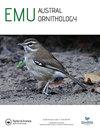Population genomics and phylogeography of four Australasian waterfowl
IF 1.1
4区 生物学
Q3 ORNITHOLOGY
引用次数: 0
Abstract
ABSTRACT Biogeographic barriers can restrict gene flow, but variation in ecological drivers of dispersal influences the effectiveness of these barriers among different species. Detailed information about the genetic connectivity and movement of waterfowl across biogeographic barriers in northern Australia and Papua New Guinea is limited. We compared genetic connectivity for four species of Australasian waterfowl that vary in their capacity and predisposition for dispersal: Radjah Shelduck (Radjah radjah), Wandering Whistling Duck (Dendrocygna arcuata), Green Pygmy Goose (Nettapus pulchellus), and Pacific Black Duck (Anas superciliosa). We obtained >3,700 loci from double-digest restriction-associated DNA sequencing for 15 to 40 individuals per species and found idiosyncratic patterns of population structure among the four species. The mostly sedentary Radjah Shelduck exhibited clear genetic differences between New Guinea and Australia as well as among locations within Australia. Although the population structure was consistent with isolation by distance, the Torres Strait and Carpentaria Barrier contributed more to genetic differences than geographic distance alone. In contrast, the presumed sedentary Green Pygmy Goose did not show obvious structure. Likewise, populations of the more dispersive Wandering Whistling Duck and Pacific Black Duck were unstructured and genetically indistinguishable between southern New Guinea and northern Australia. Our data suggest that some Australo-Papuan biogeographical barriers are insufficient to impede gene flow in waterfowl species capable of dispersing great distances. In sedentary species like the Radjah Shelduck, these barriers, perhaps coupled with its ecology and natural history, restrict gene flow. Our findings bring new insight into the population ecology of Australo-Papuan waterfowl.四种澳大拉西亚水禽的种群基因组学和系统地理学
生物地理屏障可以限制基因流动,但传播的生态驱动因素的差异会影响这些屏障在不同物种间的有效性。关于水禽在澳大利亚北部和巴布亚新几内亚跨越生物地理障碍的遗传连通性和运动的详细信息有限。我们比较了四种澳大利亚水禽的遗传连通性,它们具有不同的传播能力和倾向:拉加鸭(Radjah Radjah)、流浪鸣禽(Dendrocygna arcuata)、绿侏儒鹅(Nettapus pulchellus)和太平洋黑鸭(Anas superciliosa)。通过双酶切限制性相关DNA测序,我们获得了每个物种15 ~ 40个个体的超过3700个位点,并发现了4个物种之间的特殊群体结构模式。大部分定居的Radjah Shelduck在新几内亚和澳大利亚以及澳大利亚境内的不同地区表现出明显的遗传差异。尽管种群结构与距离隔离一致,但托雷斯海峡和卡奔塔利亚屏障对遗传差异的贡献大于地理距离。相比之下,假定久坐不动的绿侏儒鹅没有显示出明显的结构。同样,在新几内亚南部和澳大利亚北部,分布更广的流浪啸鸭(Wandering Whistling Duck)和太平洋黑鸭(Pacific Black Duck)的种群也没有结构,在基因上无法区分。我们的数据表明,一些澳大利亚-巴布亚生物地理障碍不足以阻碍能够远距离传播的水禽物种的基因流动。在像Radjah Shelduck这样定居的物种中,这些障碍,可能加上它的生态和自然历史,限制了基因的流动。我们的发现为澳大利亚-巴布亚水禽的种群生态学带来了新的见解。
本文章由计算机程序翻译,如有差异,请以英文原文为准。
求助全文
约1分钟内获得全文
求助全文
来源期刊

Emu-Austral Ornithology
生物-鸟类学
CiteScore
2.00
自引率
7.70%
发文量
33
审稿时长
>12 weeks
期刊介绍:
Emu – Austral Ornithology is the premier journal for ornithological research and reviews related to the Southern Hemisphere and adjacent tropics. The journal has a long and proud tradition of publishing articles on many aspects of the biology of birds, particularly their conservation and management.
 求助内容:
求助内容: 应助结果提醒方式:
应助结果提醒方式:


